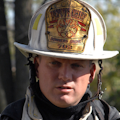First Due: The Anatomy of Fear and Stress
The way that we react to pressure—call it stress, if you will—is a condition that all humans experience. Scientific research demonstrates that the physiological effects of stress significantly impact task performance in life-and-death situations. Stress can stimulate us to perform at our best, or it can cause us to give up and concede a position. The way that a firefighter reacts to life-and-death stressors mostly will be determined from past experiences, either in reality or training.
When stressed, some bodily skills and functions shut down to enhance others. This is an automatic response of the sympathetic nervous system, which directly can affect heart rate, motor skill coordination and logic. Once the system is activated, it’s difficult for a person to regain control. As a result, instinctive physical reactions to stress might be totally different than the actions that truly are needed to survive a situation.
The body responds to stressors by releasing fats and sugars into the bloodstream to provide quick energy; breathing rates increase to add oxygen to blood as muscles tense. Stress changes how the brain functions; chemicals that are released into the bloodstream cause a person to act without conscious thought. These actions will be based largely on habits and repetition.
A person’s heart rate in turn also increases when a person is stressed to provide additional blood to the muscles. However, at a heart rate of 115 beats per minute (bpm), fine motor skills, dexterity and hand-eye coordination begin to decrease. (This is different from heart rate being increased due to exercise, because it’s induced by the release of hormones into the blood.)
At 145 bpm, complex motor skills begin to diminish, along with the ability to hear. It has been estimated that at 175 bpm, a person’s visual field decreases by as much as 70 percent. Depth perception is lost. Short-term memory loss and/or critical-stress amnesia also can occur.
When the heart rate reaches 185 bpm, a person’s ability to think logically is affected negatively, which can cause irrational behavior or combativeness, even against the very people who are trying to assist the person.
Breathe
If fear or panic begins to take over when firefighters face a crucial situation, they must get control of their breathing. This is difficult unless developed through practice.The firefighter has a limited amount of air. Slow, even breathing helps to slow heart rate, to lower the emotional arousal level and to help a person to feel more in control.
NIOSH calculates rated capacities of SCBA at 40 liters per minute. In reality, firefighters who are on the fireground can breathe at a rate of 80–120 liters per minute. Add stress and panic to the equation, and you can see why air supply is a priority.
Also, controlling breathing helps to suppress the effects of the sympathetic nervous system. Regular consumption tests allow a firefighter to practice and perfect breathing techniques and help to promote emotional stability while wearing SCBA.
As well, firefighters must quickly: focus on sight, sound and touch; organize their thoughts; apply actions from training; and establish radio communications (human voice contact).
However, the best way to control reaction to fear or panic is to prepare. Skill confidence goes a long way in controlling reaction to stress. This only can occur through ongoing training programs that reinforce skills, are kept simple and are continual.
Survival skills should be taught in steps, to develop a mental picture of each. Once mastered, steps should be combined to perform the skill. Survival skills should focus on gross motor skills, because fine motor skills become difficult under stress.
Equally important: realistic, scenario-based training. The fight-or-flight syndrome can be dictated by perception. What one member perceives as life-threatening might seem routine to another who lived through or replicated the scenario in training.
Visualization of being in a high-risk scenario and how it should be mitigated before it happens is another way to prepare.
The key to surviving any fireground situation is individual attitude. Many firefighters died in the line of duty after they “gave up,” despite being within five feet of reaching their egress point.
Firefighters must never freeze mentally or physically. Confidence and comfort in skills, which is gained via training, are paramount. If firefighters train enough, they will default to the correct actions.
About the Author

Jeffrey Pindelski
JEFFREY PINDELSKI is the Downers Grove, IL, Fire Department Chief (Ret.) and has been a student of the fire service for more than 30 years. He served as a chief officer for more than 15 years of his career, during which time he directly managed every aspect of the fire department at one time or another. Pindelski holds a master's degree in Public Safety Administration from Lewis University and earned a Graduate Certificate in Managerial Leadership and a bachelor's degree from Western Illinois University. He is the co-author of "R.I.C.O.- Rapid Intervention Company Operations" and was a revising author of the third edition of "Firefighter's Handbook." Pindelski presented at numerous fire service conferences and had more than 55 articles published in trade journals on various fire service-related topics. He is a recipient of Illinois' Firefighting Medal of Valor.
